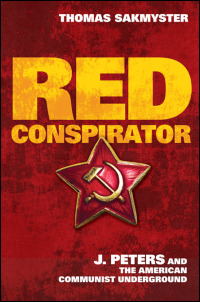 When some years ago I decided to write a biographical study of J. Peters, a shadowy figure in the history of American communism, I knew that I would face a formidable challenge in finding relevant sources. I soon confirmed what I had expected: during his years of “underground” activity in the 1930s and 1940s Peters had left behind almost no paper trial. In that era Communist party activists who were involved in what was referred to as “special work” were warned to avoid written communications. If documents had to be produced, they were to be kept in secret archives and, when no longer needed, destroyed. As a result I was not able to find a single personal letter written by Peters during his 25 year sojourn in the United States., and only a few scattered documents dealing with his conspiratorial work.
When some years ago I decided to write a biographical study of J. Peters, a shadowy figure in the history of American communism, I knew that I would face a formidable challenge in finding relevant sources. I soon confirmed what I had expected: during his years of “underground” activity in the 1930s and 1940s Peters had left behind almost no paper trial. In that era Communist party activists who were involved in what was referred to as “special work” were warned to avoid written communications. If documents had to be produced, they were to be kept in secret archives and, when no longer needed, destroyed. As a result I was not able to find a single personal letter written by Peters during his 25 year sojourn in the United States., and only a few scattered documents dealing with his conspiratorial work.
On the other hand, I had high hopes of finding useful material in FBI records., since J. Edgar Hoover and his agents had devoted considerable manpower to years of surveillance of this “man of mystery.” In 2001 I applied under the Freedom of Information Act for the pertinent FBI files. After many months I finally received two large packages in the mail, each containing a foot high stack of documents. But my excitement quickly turned to disappointment as I examined the material and found that nearly every page of it contained long blacked out sections. Almost nothing of value to a historian remained. Two reasons were cited for censoring the records in this way: the need to protect the privacy of informants and other innocent individuals; and considerations of national security.
Not wishing to spend time in mounting a legal challenge to the FBI’s decision, I turned to the investigation of other important sources, including new material from the Comintern archive in Russia. A few years later a colleague encouraged me to try again with the FBI, since there were reports from historians who were having better success with sensitive material from the 1930s and 1940s. This time I argued in my application that surely issues of national security were no longer involved, since the Soviet Union had collapsed and only historians were now concerned with the activity of the American Communist Party in that era. Perhaps my argument was persuasive, for in time I received the same two packages of documents, but this time almost nothing was blacked out.
With the greatest interest I pored over the file and found much of interest. But I soon discovered that the FBI had never really discovered anything about Peters’s espionage activity. It then dawned on me that the probable reason for the initial censorship of the file was not in fact national security (since there were no such secrets involved), but the protection of the reputation of the FBI. For the file of J. Peters showed that FBI agents on occasion used dubious, and even illegal, procedures in their attempt to find incriminating evidence about an individual they felt sure was a Soviet agent. In the end they could prove only one crime against him: the use of a forged passport. This was the charge that led to J. Peters’s deportation in 1949.
*****
Thomas Sakmyster, professor emeritus of history at the University of Cincinnati, is the author of the new book Red Conspirator: J. Peters and the American Communist Underground.
